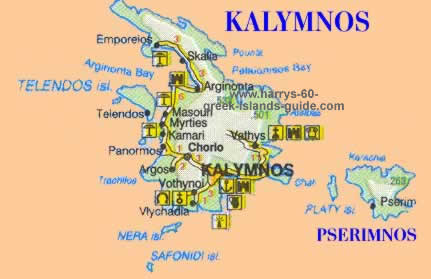Kalymnos Characteristics

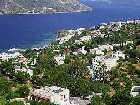 Kalymnos, lying between Kos and Leros, is the 4th largest island of the Dodecanese.
Kalymnos' population is 18,253, with a land mass of 111 sq. km and 96
km. of coastline. It is 183 nautical miles from Piraeus. This island is mountainous
and dry with fertile valleys. There are two medieval castles on
Kalymnos, therapeutic springs, caves and many churches.
Kalymnos, lying between Kos and Leros, is the 4th largest island of the Dodecanese.
Kalymnos' population is 18,253, with a land mass of 111 sq. km and 96
km. of coastline. It is 183 nautical miles from Piraeus. This island is mountainous
and dry with fertile valleys. There are two medieval castles on
Kalymnos, therapeutic springs, caves and many churches.
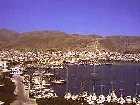 The interior
of Kalymnos remains pristine and wonderful for hiking. Three almost parallel
mountain ranges divide Kalymnos running from NW to SE. Between these
lie two fertile plains upon which the two main villages lie. Vathis or (Deep) in the north and Kalymnos Town (Hora) or Pothia,
its main harbor, in the south. The north coast of Kalymnos is virtually
uninhabited.
The interior
of Kalymnos remains pristine and wonderful for hiking. Three almost parallel
mountain ranges divide Kalymnos running from NW to SE. Between these
lie two fertile plains upon which the two main villages lie. Vathis or (Deep) in the north and Kalymnos Town (Hora) or Pothia,
its main harbor, in the south. The north coast of Kalymnos is virtually
uninhabited.
Island Features
 Arriving in Kalymnos at twilight is a wonderful experience if you can arrange your schedule that way. The sunset with the moon rising in the east as you sail into the harbor is Greek island perfection. With the colorful houses draped over the hills, it's photogenic even if you arrive by daylight.
Arriving in Kalymnos at twilight is a wonderful experience if you can arrange your schedule that way. The sunset with the moon rising in the east as you sail into the harbor is Greek island perfection. With the colorful houses draped over the hills, it's photogenic even if you arrive by daylight.
The down-to-earth and welcoming citizens are a relief after
visiting islands catering to mass tourism. Pothia is a refreshing glimpse into the real Greece of tradition.
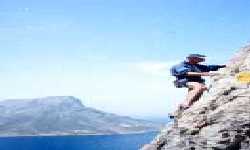 Kalymnos was famous as a
sponge diving center and even though the local sponge beds have declined, sponge diving
still employs almost 400 Kalymniots who leave for 4 month stints to
plumb the depths around Crete and N. Africa.
Kalymnos was famous as a
sponge diving center and even though the local sponge beds have declined, sponge diving
still employs almost 400 Kalymniots who leave for 4 month stints to
plumb the depths around Crete and N. Africa.
Kalymnos is great island if you are into rock-climbing and scuba diving.
 There was a significant archaeological find in 2001, which is not completely excavated yet. It contains a trove of sculptures gathered by 4th Century Christians from the island's pagan temples and buried in a pit under a now ruined basilica. There is squabbling over whether the magnificent finds being unearthed will stay in Kalymnos or go to Athens, so check on the scene to see if anything is on display yet.
There was a significant archaeological find in 2001, which is not completely excavated yet. It contains a trove of sculptures gathered by 4th Century Christians from the island's pagan temples and buried in a pit under a now ruined basilica. There is squabbling over whether the magnificent finds being unearthed will stay in Kalymnos or go to Athens, so check on the scene to see if anything is on display yet.
Pothia
 Kalymnos' capital
Pothia is the third largest city of the Dodecanese and a busy working harbor
with real Greeks going about their daily lives. The town is set in an
attractive bay and rises halfway up the hills covering most the island's
largest valley. The forward areas stretch upward to the old capital
of Hora.
Kalymnos' capital
Pothia is the third largest city of the Dodecanese and a busy working harbor
with real Greeks going about their daily lives. The town is set in an
attractive bay and rises halfway up the hills covering most the island's
largest valley. The forward areas stretch upward to the old capital
of Hora.
The nighttime landmark is the huge illuminated cross on a hilltop near the Ag. Panton (Monastery of All Saints).
The Archaeology Museum (Tu-Sun, 8:30-3, Tel: 23113) just off Platea Kyprou holds finds from
Kalymnos' Neolithic and Bronze Age past. There are Victorian furnishings, portraits and panoramas of Constantinople here. The Sponge Factory (open
daily, 8:30-2, Tel: 28501) has a complete and interesting history of
spongers and the dangerous occupation of retrieving them.
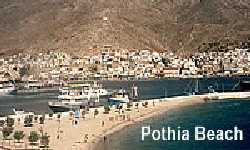
 There are many old
mansions, enclosed orchards and fine views to be seen back of the port. On the water front, you'll notice a mixture of old buildings marked
by the Italianate influence with fanciful pink domed buildings. And there are the newer usual tourist enterprises, souvenir shops, restaurants,
and ticket agencies.
There are many old
mansions, enclosed orchards and fine views to be seen back of the port. On the water front, you'll notice a mixture of old buildings marked
by the Italianate influence with fanciful pink domed buildings. And there are the newer usual tourist enterprises, souvenir shops, restaurants,
and ticket agencies.
Pothia has a very good hospital and one of the few orphanages in Greece. The mermaid in the harbor is one of many works donated to the island by the local sculptors Irene and Michalis Kokkinos.
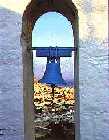
 The old Governors
Palace now houses the central market and police station.
The slavishly reconstruted silver-domed Cathedral of Aghios Christos is right on the
water. Within the church are many paintings by local artists.
The old Governors
Palace now houses the central market and police station.
The slavishly reconstruted silver-domed Cathedral of Aghios Christos is right on the
water. Within the church are many paintings by local artists.
In the NW section
of town, just behind the port and marked by three windmills, is the Myli quarter and above, stands the ruined Castle of the Knights (Kastro Chryssocheria or golden handed). Chorio or the old town is
just above and dominated by the pirate-proof Citidal of Pera Kastro.
Hora the old capital
Even thought it's a strenuous climb, the views are spectacular from the top where the old capital was located. Hora took
root under the protection of Pera Kastro, the fortress which served as
refuge during the middle ages. It's a forbidding structure, whose interior holds
even earlier ruins of habitation. On its crags stand nine chaples, which locals
faithfully keep spotlessly white washed.
Near Hora's
hospital at the foot of Mt. Flaska is the Cave of the Nymphs, or Cave of the Seven Virgins, which has
never been fully explored. Within may be seen traces of ancient worship where
devotees poured libations. Legend has it that seven maidens sought refuge in its
depths from pirates only to become lost and never be seen again.
Just beyond
Hora stands the islands old cathedral Panagia ths Kechaitomeni which was
partially built using the existant columns of the Hellenistic Temple of Apollo.
Kalymnos' Beaches
See the map of the island beaches in the Map section below. On the west coast, starting from Pothia, (with its own strip of sand), ascend to Hora and down
the road to Kalymnos' western shore. A string of beaches begins here starting
with Kantouni, Panormos and Elies.
Linaria follows and then Plati Gialos and Melitzahas. The heart of tourism lies at Myrties. The sunset over the islet of Telendos from Myrties is one of Kalymnos' most famous sights.
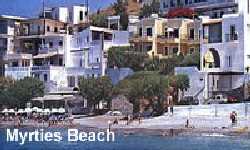 Myrties
metamorphizes into Massouri with its ugly, neon-lit roadway. Finally, near the
end, you approach Armeos.
Myrties
metamorphizes into Massouri with its ugly, neon-lit roadway. Finally, near the
end, you approach Armeos.
Keep following the scenic west coast road to Emborio, the northern most of Kalymnos' villages is
a small fishing village with a small pebble beach and a few tavernas and
rooms to let. Nearby is the Cave of Kolonostilo (or Cyclops Cave), a spelunker's
dream. There has been damage to the stalactities and structures in the cave, but it's still amazing. Neolithic ruins and a sacrificial alter were discovered near the
ruined Venetian Castle close by. The road along the coast affords majestic
views!
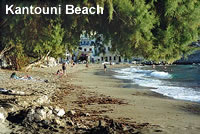

Telendos Islet
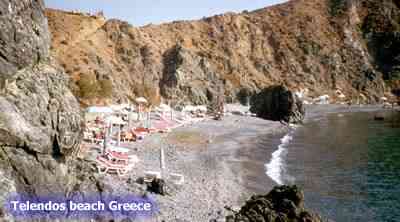
Just opposite (700m) Myrties, the isle
of Telendos offers nude bathing and wonderful sunsets. Telendos
is reachable by water-taxi from Myrties, which may be reached from Pothia
by bus every half hour. Telendos broke off from Kalymnos in an earthquake
during the 6th Century AD. It has several small pebble beaches of which Choklaka (Hohlakas) is the most popular.
There is a small village/harbor with tavernas and a
few rooms to let. High above the beaches stands the Byzantine Monastery
of Aghios Konstandinos while below may be found the ruins of Roman houses.
A good palce to beat the hordes.
The Fjord-like East Coast: Vathi
 Kalymnos'
central valley Vathi is a verdant place with three villages
and many fragrant citrus orchards. Metochi, dead in the center
of the island is an agrarian community. Platanos, the most central
of the three is named for its large plane tree and has pre- Myceanaen cyclopean
walls close by. Rina is the port and sits at the mouth of
a deep fjord. Near the mouth of the fjord is the Cave of Daskeleio.
In its inner stalactite chamber were discovered a horde of Neolithic and
Bronze Age items, now on display in Pothia.
Kalymnos'
central valley Vathi is a verdant place with three villages
and many fragrant citrus orchards. Metochi, dead in the center
of the island is an agrarian community. Platanos, the most central
of the three is named for its large plane tree and has pre- Myceanaen cyclopean
walls close by. Rina is the port and sits at the mouth of
a deep fjord. Near the mouth of the fjord is the Cave of Daskeleio.
In its inner stalactite chamber were discovered a horde of Neolithic and
Bronze Age items, now on display in Pothia.
Drinking and Dining
 In Pothia, Octopus
Row at the far right of the harbor and behind the Police
Building has most of Pothia's restaurants. Vouvali's is good
and so is Minore.
In Pothia, Octopus
Row at the far right of the harbor and behind the Police
Building has most of Pothia's restaurants. Vouvali's is good
and so is Minore.
Near the Church of Metropolis is Xefteris with a garden and traditional cuisine. Harborside, Ouzerie Athinas has good shrimp and mezedes.
History
In the 11th Century, almost everyone on the island was killed during a Turkish invasion. Later the Knights of St John came to the island and strengthened the fortress of Kastro. They left the island in the 1500s.
During the Italian occupation many local citizens were jailed or exiled for opposing the Fascist line.
Local women have a tradition of independence since the men are off at sea frequently and for long stretches of time. Women lead the protests against the Italians and in 1996 painted everything the blue and white of Greece as an act of defiance. Things are peaceful now, I'm happy to report.
Sponge fishing was a flourishing industries on Kalymnos for centuries. As early as 500 BC there are examples in Greek art of sponge divers. In those days, there were no rubber suits, helmets, or any other protective gear. In fact, the diver carried a heavy stone to hold himself underwater near the sponge beds.





 Kalymnos, lying between Kos and Leros, is the 4th largest island of the Dodecanese.
Kalymnos' population is 18,253, with a land mass of 111 sq. km and 96
km. of coastline. It is 183 nautical miles from Piraeus. This island is mountainous
and dry with fertile valleys. There are two medieval castles on
Kalymnos, therapeutic springs, caves and many churches.
Kalymnos, lying between Kos and Leros, is the 4th largest island of the Dodecanese.
Kalymnos' population is 18,253, with a land mass of 111 sq. km and 96
km. of coastline. It is 183 nautical miles from Piraeus. This island is mountainous
and dry with fertile valleys. There are two medieval castles on
Kalymnos, therapeutic springs, caves and many churches.  Arriving in Kalymnos at twilight is a wonderful experience if you can arrange your schedule that way. The sunset with the moon rising in the east as you sail into the harbor is Greek island perfection. With the colorful houses draped over the hills, it's photogenic even if you arrive by daylight.
Arriving in Kalymnos at twilight is a wonderful experience if you can arrange your schedule that way. The sunset with the moon rising in the east as you sail into the harbor is Greek island perfection. With the colorful houses draped over the hills, it's photogenic even if you arrive by daylight.  Kalymnos was famous as a
sponge diving center and even though the local sponge beds have declined, sponge diving
still employs almost 400 Kalymniots who leave for 4 month stints to
plumb the depths around Crete and N. Africa.
Kalymnos was famous as a
sponge diving center and even though the local sponge beds have declined, sponge diving
still employs almost 400 Kalymniots who leave for 4 month stints to
plumb the depths around Crete and N. Africa. There was a significant archaeological find in 2001, which is not completely excavated yet. It contains a trove of sculptures gathered by 4th Century Christians from the island's pagan temples and buried in a pit under a now ruined basilica. There is squabbling over whether the magnificent finds being unearthed will stay in Kalymnos or go to Athens, so check on the scene to see if anything is on display yet.
There was a significant archaeological find in 2001, which is not completely excavated yet. It contains a trove of sculptures gathered by 4th Century Christians from the island's pagan temples and buried in a pit under a now ruined basilica. There is squabbling over whether the magnificent finds being unearthed will stay in Kalymnos or go to Athens, so check on the scene to see if anything is on display yet.  Kalymnos' capital
Pothia is the third largest city of the Dodecanese and a busy working harbor
with real Greeks going about their daily lives. The town is set in an
attractive bay and rises halfway up the hills covering most the island's
largest valley. The forward areas stretch upward to the old capital
of Hora.
Kalymnos' capital
Pothia is the third largest city of the Dodecanese and a busy working harbor
with real Greeks going about their daily lives. The town is set in an
attractive bay and rises halfway up the hills covering most the island's
largest valley. The forward areas stretch upward to the old capital
of Hora.
 There are many old
mansions, enclosed orchards and fine views to be seen back of the port. On the water front, you'll notice a mixture of old buildings marked
by the Italianate influence with fanciful pink domed buildings. And there are the newer usual tourist enterprises, souvenir shops, restaurants,
and ticket agencies.
There are many old
mansions, enclosed orchards and fine views to be seen back of the port. On the water front, you'll notice a mixture of old buildings marked
by the Italianate influence with fanciful pink domed buildings. And there are the newer usual tourist enterprises, souvenir shops, restaurants,
and ticket agencies.
 The old Governors
Palace now houses the central market and police station.
The slavishly reconstruted silver-domed Cathedral of Aghios Christos is right on the
water. Within the church are many paintings by local artists.
The old Governors
Palace now houses the central market and police station.
The slavishly reconstruted silver-domed Cathedral of Aghios Christos is right on the
water. Within the church are many paintings by local artists. Myrties
metamorphizes into Massouri with its ugly, neon-lit roadway. Finally, near the
end, you approach Armeos.
Myrties
metamorphizes into Massouri with its ugly, neon-lit roadway. Finally, near the
end, you approach Armeos. 


 Kalymnos'
central valley Vathi is a verdant place with three villages
and many fragrant citrus orchards. Metochi, dead in the center
of the island is an agrarian community. Platanos, the most central
of the three is named for its large plane tree and has pre- Myceanaen cyclopean
walls close by. Rina is the port and sits at the mouth of
a deep fjord. Near the mouth of the fjord is the Cave of Daskeleio.
In its inner stalactite chamber were discovered a horde of Neolithic and
Bronze Age items, now on display in Pothia.
Kalymnos'
central valley Vathi is a verdant place with three villages
and many fragrant citrus orchards. Metochi, dead in the center
of the island is an agrarian community. Platanos, the most central
of the three is named for its large plane tree and has pre- Myceanaen cyclopean
walls close by. Rina is the port and sits at the mouth of
a deep fjord. Near the mouth of the fjord is the Cave of Daskeleio.
In its inner stalactite chamber were discovered a horde of Neolithic and
Bronze Age items, now on display in Pothia.  In Pothia, Octopus
Row at the far right of the harbor and behind the Police
Building has most of Pothia's restaurants. Vouvali's is good
and so is Minore.
In Pothia, Octopus
Row at the far right of the harbor and behind the Police
Building has most of Pothia's restaurants. Vouvali's is good
and so is Minore. 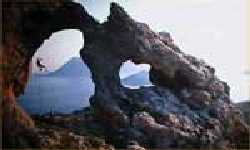 Many people come here for the rugged rock climbing activities you can find on the island. There are spectacular limestone walls backing the resorts. There are 21 documented climbs.
Many people come here for the rugged rock climbing activities you can find on the island. There are spectacular limestone walls backing the resorts. There are 21 documented climbs. 
